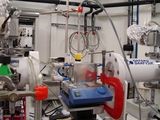Title of Research Group: Functional amorphous carbon materials group
Principal Investigator: Paula E. Colavita
Institution: Trinity College Dublin
School: Chemistry
Research: The aim of my work is that of improving our understanding of non-crystalline materials in order to translate such understanding into enhanced functionality and practical applications. Over the past years I have focused, in particular, on the chemistry of non-crystalline/amorphous carbon materials. Disordered forms of carbon have been used for at least a century for the most diverse applications, from adsorbents to electrodes, catalyst supports, and biodevice coatings. My group at TCD has worked towards applying and developing methods of growth, deposition, modification and characterization in order to discover structure/reactivity relationships in disordered carbons. Control of surface reactivity has been identified as underpinning the rational design of carbon biomaterials, carbons for environmental applications, new carbon catalysts and electrode materials, and sensors. We use materials design in order to investigate fundamental interfacial processes; in turn, we also apply our understanding of surface reactivity to create smart interfaces with enhanced functionality. Recently, we have worked on the synthesis of metal/carbon nanostructured materials. Metal nanoparticles can serve as catalytic centres which combined with high specific area carbons result in interesting catalytic and electrocatalytic systems with applications in energy conversion, environmental and industrial technologies. For instance, we currently work on the design of non-noble metal electrocatalysts for fuel cells, reactive adsorbers and bioimaging agents.
We have used synchrotron radiation in the past in order to characterise our materials via X-ray absorption spectroscopy (EXAFS and XANES). The use of a technique like EXAFS has been essential to our research because most of our materials are disordered, lacking the long range order needed for characterisation via diffraction techniques. We have carried out our work in collaboration with Beamline scientists at SOLEIL and we and our publications have greatly benefitted from access to SR facilities. Our most recently funded projects (SFI and IRC funded) are in the area of carbon electrocatalyst development and we will need SR access in order to characterise our materials via EXAFS. This type of characterisation is essential for high impact publication and for carrying out competitive research in the area of energy conversion. Lack of access to beamtime would negatively impact our work in the near- and mid-term future.
Techniques: XAS/NEXAFS
Facilities: SOLEIL
Beamlines: SAMBA
Group (as of 2014): 6 PhD, 4 Postdoctoral researchers, 1 Research Assistant
Participating group members at SR/FEL/neutron facilities (period 2008-2014):
1 PhD
Impact: Our work in the area of carbon based catalytic systems is important for developing new tools for enhancing the performance of these materials and for the design of novel applications in response to the need for: (a) green sustainable technologies, (b) transport and manufacturing activities with lower carbon footprint and (c) new energy conversion and storage capabilities. For this reason the project maps onto the Energy & Energy Efficient Technologies remit of Science Foundation Ireland and onto the “Processing Technologies and Novel Materials” and “Manufacturing Competitiveness” priority areas (areas L and M) identified in the Research Prioritisation Exercise Report. .
Publication Highlights:
Duffy, P.; Cullen, R. J.; Jayasundara, D. R.; Murphy, D. M.; Fonda, E.; Colavita, P. E., Electroless deposition and characterization of Fe/FeOx nanoparticles on porous carbon microspheres: structure and surface reactivity. Journal of Materials Chemistry A 2013, 1 (19), 6043-6050.
Duffy, P.; Magno, L. M.; Yadav, R. B.; Roberts, S. K.; Ward, A. D.; Botchway, S. W.; Colavita, P. E.; Quinn, S. J., Incandescent porous carbon microspheres to light up cells: solution phenomena and cellular uptake. Journal of Materials Chemistry 2012, 22 (2), 432-439.
Website: Group Website



